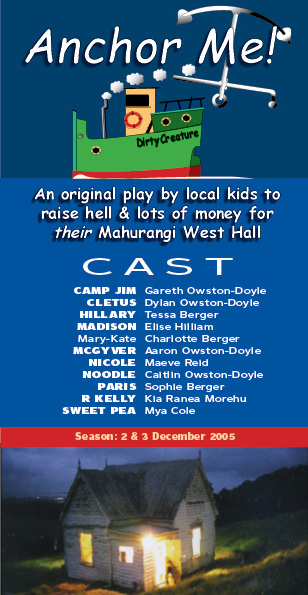Book now for the 10th anniversary screening of Anchor Me!

Case of the Elusive Videotape: Original plan was for the video of Anchor Me! to be screened at the same time the following year. However, the videotape, shot by Maree Owston-Doyle, took on a life of its own, going to ground whenever its name was mentioned, perhaps precociously taking on airs and aping The Scottish Play. Regardless, life, and not least of all the restoration of the Mahurangi West Hall, got in the way until the enormity of the impending passing of a decade since the production played loomed, and the tape was tracked down, but not without vanishing again briefly, one last time. Design Cimino Cole 2005 Hall image Lyn Bergquist
Some of the best, ironic lines came from the cast.
This shouldn’t have come as a surprise, given that the original concept was for the children to write the entire play.
That that notion was unrealistic became clear at the first workshop, held in the yet-to-be restored hall on a Sunday afternoon sometime when, like now, it was more winter than spring, 10 years ago. The good muster of Mahurangi West children, of which only a few had hit their teens, were surprisingly delighted to be in each other’s company, despite spending more than an hour and a half every weekday together aboard their school bus that laboured over the hills between home and Warkworth. But as for showing any propensity for writing their own play, inventing the name of the character they would play seemed to exhaust any enthusiasm for wordsmithing.
But the real fun began when it was time to head home, and enthusiasm for the proposition of walking, rather than being collected by parents, spread like a contagion. Appropriately briefed on how to walk safely on the country road, the cast departed en mass, with the producer driving ahead, and the director acting as rear guard, cautioning passing cars. That none was hit on the several-kilometre walk home was more the product of safety in numbers than best-practices, but it was clearly the high point of the afternoon for the children, and the ensuing dialogue as they bossed each other with whichever snippet of the road safety tuition they’d remembered, or misremembered, provided the model for how the play would evolve, and the appropriate vernacular for it.
That night, possibly stimulated by the spectre of the needless and avoidable loss of great-nephews or nieces, or the children of neighbours, insomnia led to the entire plot of the play emerging fully formed, but sans the dialogue. Thus the play progressed, from Sunday to Sunday, with the director as playwright struggling to keep ahead of the cast, and the cast struggling to learn their lines, often revised to incorporate pearls from the previous week’s rehearsal, unintentionally provided, and subsequently unselfconsciously delivered.
An early boost was provided by professional set builder Lyn Bergquist realising a fanciful craft suggested by a much earlier and cruder apparition that, fortunately for its conceiver, never got close to river trials in the nearby King Country Mangaokewa Stream, circa mid-1950s, thanks to parental intervention. It was possibly about the time of the set building that Kiwi music began to infuse itself, with Dirty Creature becoming the name for the gunkholing flat-bottomed cross-sectioned craft that served as both set and stage, cannily occupying little more than a metre of width of one end of the hall. In any event, Anchor Me supplied the play’s title, styled with an exclamation mark, to lessen copyright breech lest Don McGlashan took umbrage, which apparently he didn’t when consulted by his Mahurangi West friends.
The play was a triumph thanks to its all-child cast, and to a deliberately lengthy, sparkling-wine-enlivened intermission. There was some expectation that it might become more regular event—there had been four previously plays, including two productions of Wind in the Willows, one of each of The Wizard of Oz and Mud River, the latter written by author Wayne Innes. However, the $135 000 open-ground indigenous plant establishment trials—aimed at reducing the muddiness of Mud River—were approved by the Sustainable Farming Fund, and tyro playwright became tyro project manager and, simultaneously, tyro suburban-and-rural-newspaper subeditor.
Meantime, but so as to not give too much away before the 5 December screening, what will not be revealed is just how close to tragedy the abseiling sequence played out on the first night…
